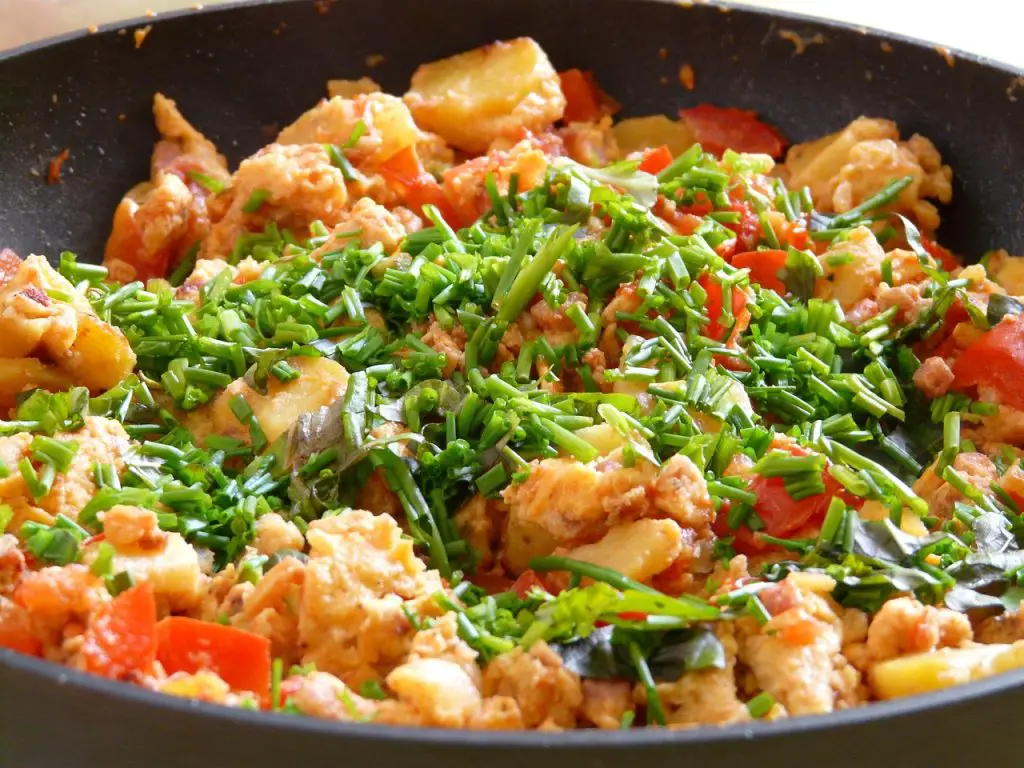Chicken stir-fry is a versatile and delicious dish that has its origins in Asian cuisine. It’s a popular choice for home cooks and restaurant-goers alike, thanks to its quick cooking time, vibrant flavors, and endless customization options. Whether you’re a novice in the kitchen or a seasoned chef, this comprehensive guide will walk you through the steps to make a mouthwatering chicken stir-fry that will rival your favorite takeout. From selecting the right ingredients to mastering the cooking techniques, you’ll learn everything you need to know to create a perfect chicken stir-fry at home.
Table of Contents
Choosing the Right Ingredients
Selecting the Chicken
Vegetables for Your Stir-Fry
Essential Aromatics and Flavorings
Noodles or Rice: The Base
Preparing Your Workspace
Gathering Equipment
Prepping Ingredients
Creating a Stir-Fry Sauce
Marinating the Chicken
Importance of Marination
Basic Chicken Marinade Recipe
Stir-Fry Cooking Techniques
The Art of High Heat
Stir-Frying vs. Sautéing
The Stir-Fry Sequence
Avoiding Common Stir-Fry Mistakes
The Perfect Stir-Fry Sauce
Classic Stir-Fry Sauce Recipe
Variations and Customization
Assembling the Stir-Fry
Searing the Chicken
Adding the Vegetables
Incorporating the Sauce
Serving and Garnishing
Plating Your Stir-Fry
Garnish and Toppings
Pairing Suggestions
Troubleshooting and Tips
Overcoming Common Stir-Fry Problems
Storage and Reheating Tips
Dietary Considerations
The Joy of Homemade Chicken Stir-Fry
Experiment and Enjoy!
Choosing the Right Ingredients
When it comes to making the perfect chicken stir-fry, selecting the right ingredients is crucial for flavor, texture, and overall satisfaction. Here’s what you need to consider:
Selecting the Chicken:
Choose boneless, skinless chicken breasts or thighs for your stir-fry. Slice them thinly and against the grain for tenderness. You can also use pre-cut chicken strips for convenience.
Vegetables for Your Stir-Fry:
Opt for a colorful array of vegetables to add flavor and nutrition. Popular choices include bell peppers, broccoli, carrots, snap peas, and mushrooms. Feel free to experiment with different combinations.
Essential Aromatics and Flavorings:
Garlic, ginger, and scallions are fundamental aromatics in many stir-fry recipes. Soy sauce, hoisin sauce, oyster sauce, and sesame oil are essential for creating that signature stir-fry flavor.
Noodles or Rice: The Base:
Stir-fries can be served over rice or noodles. Jasmine or basmati rice works well, or you can use rice noodles, udon, or egg noodles. Make sure to cook these as per the package instructions.
Preparing Your Workspace
Before diving into the cooking process, it’s crucial to set up your workspace correctly. Here’s what you’ll need:
Gathering Equipment:
Wok or large skillet: A wok is traditional, but a large skillet will work just fine.
Sharp knife and cutting board: For slicing chicken and chopping vegetables.
Mixing bowls: For marinating the chicken and mixing sauces.
Wooden spatula or wok spatula: Essential for stir-frying.
Measuring cups and spoons: To ensure accuracy in your sauce.
Prepping Ingredients:
Wash and chop all your vegetables before starting to cook. This ensures you have everything ready to go.
Slice the chicken thinly and evenly for even cooking.
Prepare garlic, ginger, and scallions by mincing or slicing them finely.
Measure out all sauce ingredients and have them readily accessible.
Creating a Stir-Fry Sauce:
Combine soy sauce, hoisin sauce, oyster sauce, and a touch of sesame oil to create a basic stir-fry sauce. You can also add sugar, rice vinegar, and chili paste for extra depth of flavor. Adjust the quantities to suit your taste.
Marinating the Chicken
Marinating the chicken is a crucial step in enhancing the flavor and tenderness of your stir-fry. While it’s possible to skip this step if you’re short on time, marinating adds an extra layer of deliciousness. Here’s a basic chicken marinade recipe:
Basic Chicken Marinade Recipe:
2 tablespoons soy sauce
1 tablespoon rice wine or dry sherry
1 teaspoon cornstarch
1 teaspoon sugar
1/2 teaspoon minced garlic
1/2 teaspoon minced ginger
Mix these ingredients in a bowl, then add your sliced chicken. Toss to coat evenly, cover, and refrigerate for at least 15-30 minutes, or longer if you have the time. Marinating for several hours or overnight can make the chicken incredibly tender and flavorful.
Stir-Fry Cooking Techniques
Now that you have your ingredients prepared and marinated, it’s time to explore the cooking techniques that make chicken stir-fry so delicious.
The Art of High Heat:
Stir-frying is all about cooking quickly over high heat. The high temperature allows the ingredients to cook rapidly while maintaining their crispness and retaining their vibrant colors. Make sure your wok or skillet is very hot before you start cooking.
Stir-Frying vs. Sautéing:
Stir-frying involves constant movement of ingredients in the pan, while sautéing typically means cooking food quickly in a small amount of oil without much movement. Stir-frying helps distribute the heat evenly and prevents sticking and burning.
The Stir-Fry Sequence:
Heat your wok or skillet over high heat and add oil.
Start with the aromatics (garlic, ginger, scallions) to infuse flavor into the oil.
Add the marinated chicken and stir-fry until it’s no longer pink and has a slight sear.
Add the hardest vegetables first (e.g., carrots and broccoli), followed by softer ones (e.g., bell peppers and snap peas).
Pour in the sauce and continue to stir-fry until everything is evenly coated and heated through.
Avoiding Common Stir-Fry Mistakes:
Overcrowding the pan can cause ingredients to steam rather than stir-fry, so use a large enough pan or work in batches.
Don’t overcook the vegetables; they should remain crisp and vibrant.
Avoid adding too much sauce, as it can make your stir-fry too salty or saucy.
The Perfect Stir-Fry Sauce
A well-balanced sauce is the heart of any great stir-fry. Here’s a classic stir-fry sauce recipe, but feel free to customize it to suit your preferences.
Classic Stir-Fry Sauce Recipe:
2 tablespoons soy sauce
1 tablespoon hoisin sauce
1 tablespoon oyster sauce
1/2 teaspoon sesame oil
Whisk these ingredients together in a bowl before adding them to your stir-fry. You can adjust the quantities of each ingredient to achieve the desired flavor. For a sweeter sauce, add a teaspoon of sugar; for some heat, incorporate chili paste or crushed red pepper flakes.
Assembling the Stir-Fry
Now that your chicken, vegetables, and sauce are prepared, it’s time to put it all together:
Searing the Chicken:
Heat your wok or skillet over high heat and add oil. Add the marinated chicken and stir-fry until it’s no longer pink and has a slight sear. This should take about 3-4 minutes. Remove the chicken from the pan and set it aside.
Adding the Vegetables:
Add a bit more oil to the pan if needed, and start stir-frying the vegetables. Begin with the hardest vegetables and work your way to the softer ones. This ensures even cooking. Be attentive and keep the vegetables moving to prevent burning.
Incorporating the Sauce:
Once the vegetables are nearly cooked, return the seared chicken to the pan. Pour in the stir-fry sauce and stir-fry for an additional 1-2 minutes, making sure everything is evenly coated and heated through. The sauce will thicken slightly as it heats.
Serving and Garnishing
Plating Your Stir-Fry:
Serve your chicken stir-fry over a bed of cooked rice or noodles. The choice is yours, and both options work wonderfully. Ensure your rice or noodles are hot before placing your stir-fry on top.
Garnish and Toppings:
Add a final touch of freshness and texture with some garnishes. Common garnishes include sliced scallions, chopped cilantro, toasted sesame seeds, or crushed peanuts. These additions not only enhance the visual appeal but also provide extra flavor and crunch.
Pairing Suggestions:
For a complete meal, consider pairing your chicken stir-fry with a side of steamed vegetables, a simple cucumber salad, or some spring rolls. A side of hot tea or a cold glass of iced green tea can complement the flavors perfectly.
Troubleshooting and Tips
No matter how skilled you are at making chicken stir-fry, it’s helpful to know how to overcome common issues:
Overcoming Common Stir-Fry Problems:
Sticking: Ensure your pan is hot enough and well-oiled before adding ingredients.
Sogginess: Overcrowding the pan can lead to steaming instead of stir-frying, resulting in soggy vegetables. Cook in batches if needed.
Overcooking: Be mindful not to overcook the vegetables; they should remain crisp.
Saltiness: If your stir-fry becomes too salty, you can dilute it with unsalted chicken broth or water.
Thickness: If the sauce is too thick, you can thin it out with a little water or chicken broth.
Storage and Reheating Tips:
Leftover chicken stir-fry can be stored in an airtight container in the refrigerator for up to 3-4 days.
Reheat it gently in a pan or in the microwave, adding a splash of water or chicken broth to maintain moisture.
Avoid freezing as vegetables may lose their crispness when thawed.
Dietary Considerations:
Chicken stir-fry is highly adaptable to dietary preferences. You can make it gluten-free by using gluten-free soy sauce or tamari.
For a vegetarian or vegan version, substitute tofu or a variety of mushrooms for the chicken and use vegan-friendly sauces.
Making chicken stir-fry at home is a rewarding culinary adventure that allows you to customize flavors, textures, and ingredients to suit your taste.
With the knowledge gained from this step-by-step guide, you can confidently create delicious and healthy stir-fry dishes that will delight your family and friends. Don’t be afraid to experiment with different ingredients and sauce variations to make this versatile dish your own. Enjoy the joy of homemade chicken stir-fry, and happy cooking!
Additional Chicken Stir-Fry Recipes
Now that you’ve mastered the basics of chicken stir-fry, it’s time to explore some exciting variations and recipes to keep your meals interesting. Here are a few ideas to get you started:
Cashew Chicken Stir-Fry: Add roasted cashews for extra crunch and a rich, nutty flavor.
Sweet and Sour Chicken Stir-Fry: Create a tangy sauce with pineapple, vinegar, and sugar for a delightful sweet and sour experience.
Teriyaki Chicken Stir-Fry: Incorporate a homemade teriyaki sauce using soy sauce, sake or white wine, sugar, and ginger.
Thai Basil Chicken Stir-Fry: Infuse Thai flavors by adding Thai basil leaves, fish sauce, and chili peppers.
Lemon Garlic Chicken Stir-Fry: Enhance the aroma and taste with fresh lemon zest and minced garlic in your sauce.
Kung Pao Chicken Stir-Fry: Introduce a spicy kick with dried red chili peppers, Sichuan peppercorns, and roasted peanuts.
Each of these variations offers a unique blend of flavors, making it easy to adapt chicken stir-fry to your personal preferences.
The Cultural Influence of Stir-Fry
Chicken stir-fry is not just a delicious dish; it also holds cultural significance in many Asian cuisines. It reflects the principles of balance, harmony, and simplicity that are fundamental in Asian cooking. Additionally, stir-frying is a cooking technique that has been passed down through generations, and every family may have its own secret recipe.
Learning about the cultural aspects of stir-fry can deepen your appreciation for this culinary tradition. Consider exploring the history and regional variations of stir-fry in Chinese, Thai, Japanese, or other Asian cuisines. You’ll gain a richer understanding of the flavors and techniques behind this beloved dish.
In conclusion, making chicken stir-fry is an art that anyone can master with practice and a bit of culinary curiosity. With the right ingredients, preparation, and cooking techniques, you can create a flavorful and satisfying meal that’s both healthy and versatile. Whether you prefer classic chicken stir-fry or enjoy experimenting with different flavors and ingredients, the possibilities are endless. So, gather your ingredients, heat up your wok or skillet, and embark on your culinary journey to perfecting the art of chicken stir-fry. It’s a delicious adventure that’s sure to delight your taste buds and impress your family and friends.




